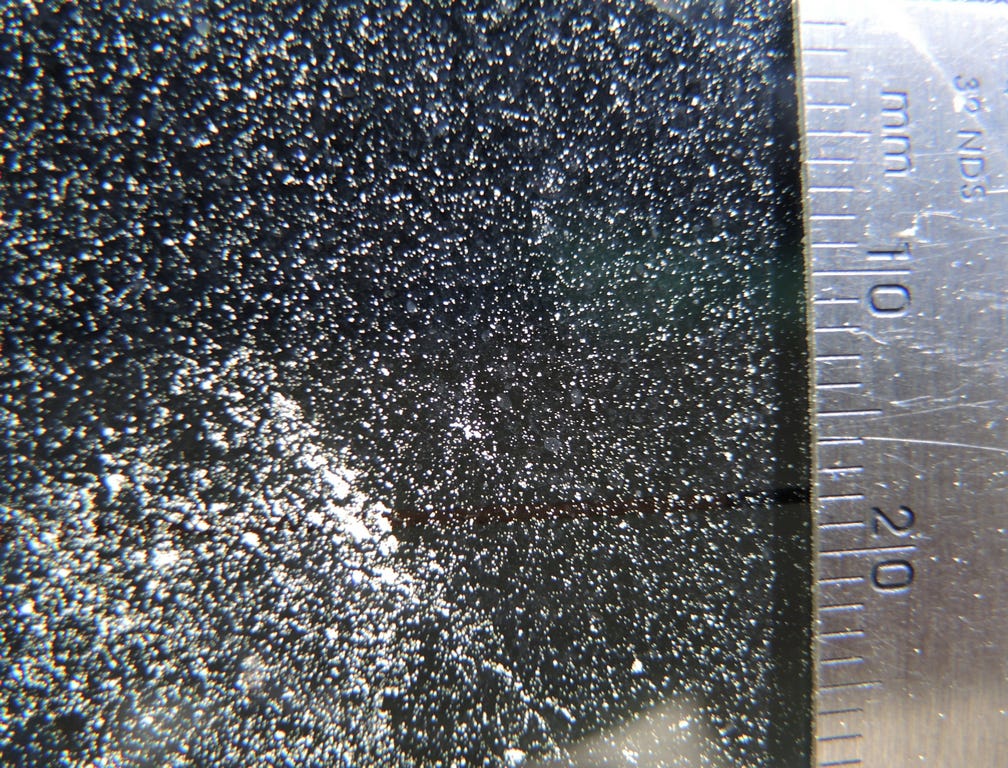
Here is grist for your imagination mill. Almost one-fifth of plant species are wind pollinated, meaning that their pollen is simply shed into the air to drift on undependable breezes in the hope of landing on the stigma of a female plant thereby fathering a seed. Examples include most large temperate forest trees such as oaks and pines, but also grasses and many species of herbaceous plants, including some crops. To remain aloft for longer than it takes to put your shoes on in the morning, the pollen grain must have a mass (or density) that is very small in relationship to the viscosity of the air (which has a mighty small viscosity). Sometimes the pollen grain is even provided with "wings" to help breezes keep it aloft. Notwithstanding, it must still land on the target stigma, and that likelihood seems pretty small.
So, here is the situation I want you to picture. The average wind-dispersed pollen grain measures about 30 µm and is 2 x 105 µm3 in volume. Pretty small, right? Let's say a plant sheds a million such grains into a cubic meter of air. That amounts to one grain per cubic centimeter, a grain that occupies a mere 1/100,000,000 of the volume of that cubic cm. Let's say the stigma is a millimeter or two in size and occupies about 1/1000 of that cubic cm that contains that one pollen grain. The flower has 20 ovules pining for fertilization and that means a minimum of 20 pollen grains must land on that tiny stigma to accomplish the task. And that is just one flower on one plant. Sure, shedding a billion grains into that cubic meter would raise the number to 1000 grains per cubic centimeter, yet they would still occupy only 1/100,000th of the cubic centimeter. You get the picture.
To increase the likelihood that a pollen grain will land on a stigma, male plants therefore shed huge amounts of pollen from projecting stamens that commit the pollen directly to the wind so that it may be carried to stigmas that project out into the pollen-carrying breezes with greatly enlarged or feathery surfaces. The fact that most female pine, oak, and grass flowers get pollinated in spite of these odds tells you how much pollen they must be shedding.

In the spring pollinating season, you don’t need sophisticated measuring instruments to get an idea of the quantities of pollen shed, you need only notice that all horizontal outdoor surfaces, such as cars or tables, assume a yellow tinge that on closer inspection is composed of thousands of pollen grains per square centimeter. My car’s windshield (below) accumulated over 1000 pollen grains per square centimeter in a single day of a pollen season that lasts multiple weeks. Here then is a visual demonstration of the wind-pollination strategy--- cover every last square millimeter!

While wind pollination may seem to require a large investment in pollen, there are savings to be had from not being insect pollinated --- plants no longer need to attract insects to transfer pollen, and they therefore produce no odors, have no nectar and no large showy flowers, opting instead for small and inconspicuous flowers so they can afford the investment in a vast supply of pollen. Because pollen is also food for many insect pollinators, wind pollinated plants make cheaper, low protein pollen, saving a bit more on their bill.
In the process of getting the pollination job done, some of these plants cause a lot of human suffering, for practically all pollen allergies are caused by wind pollinated plants. In spite of the almost universal conviction that fall hay fever is caused by goldenrod, it is actually mostly caused by ragweed, a common, inconspicuous weed that blooms at the same time as ragweed. The sly, nondescript ragweed is happy to let the blame settle on the show-off, conspicuous goldenrod, and most people are very casual about distinguishing between causation and correlation! These same people probably also believe that hospitals kill people.
And yet, wind pollination seems to work for the conifers, many large broadleaf forest trees, and most grasses. Given the improbability of a grain landing on a stigma, and the amount of pollen produced, it is an amazing, marvelous phenomenon, one of nature’s many spectacles, and a necessary adaptation to deal with an extremely improbable event. Its motto seems to be, if at first you don't succeed, try another ten trillion times.

I eventually came to see wind pollination as a form of contamination. One spring, as the pines were coating Tallahassee in yellow, an undergraduate (I'll call her Leslie) was doing a research project in my lab that required her to make up sugary solutions dyed with rhodamine B, an intensely fluorescent pink dye. The 500-gram bottle of very fine powder in my drawer was enough to color all of Tallahassee's water pink. Unfortunately, finely powdered as the dye was, it follows the same physical rules as wind-carried pollen--- easily lofted by even the gentlest of air currents and subject to static electric charges. Its dust-size particles remain unnoticed until contacting moisture, as for example, damp human skin or a wiped lab counter. Then pink spots blossom magically. Under ultraviolet light, my lab looked like the aftermath of a pink snowstorm. So, Leslie quickly earned the affectionate nickname, Miss Contamination. But to be fair, she was not particularly sloppy. It is simply that very fine powders obey physical rules that we are barely aware of. At our large scale, the world may look clean and orderly, but at the scale of pollen, spores, bacteria and rhodamine powder, contamination is the rule, not the exception, and everything, but everything, is contaminated. This contamination may be annoying in your dusty house, or my rhodamine contaminated lab, but it is the very essence of wind pollination. It is contamination put to good use.





Pollenaise: Pollen so thick you could spread it on bread?
(Great essay!)
The magical gracefulness of reproduction….